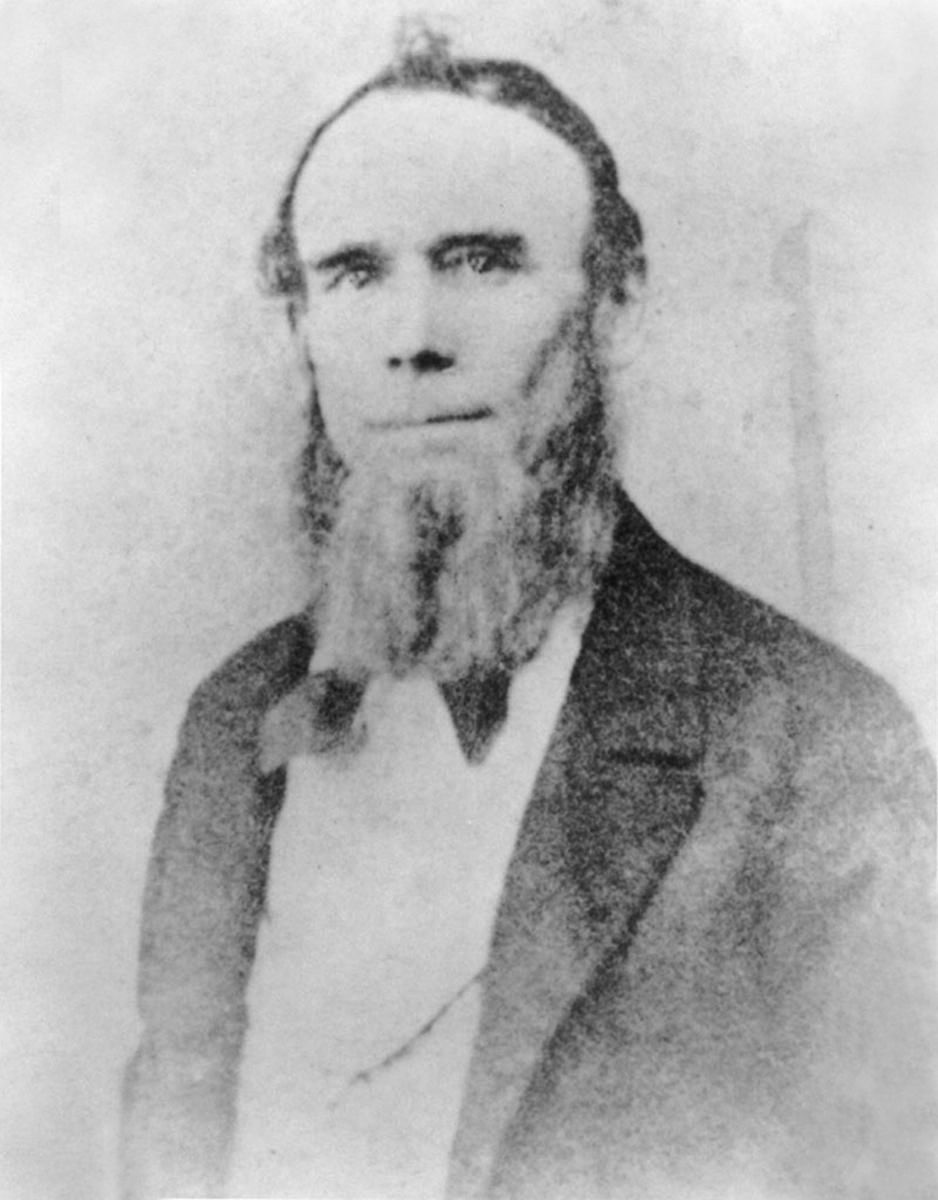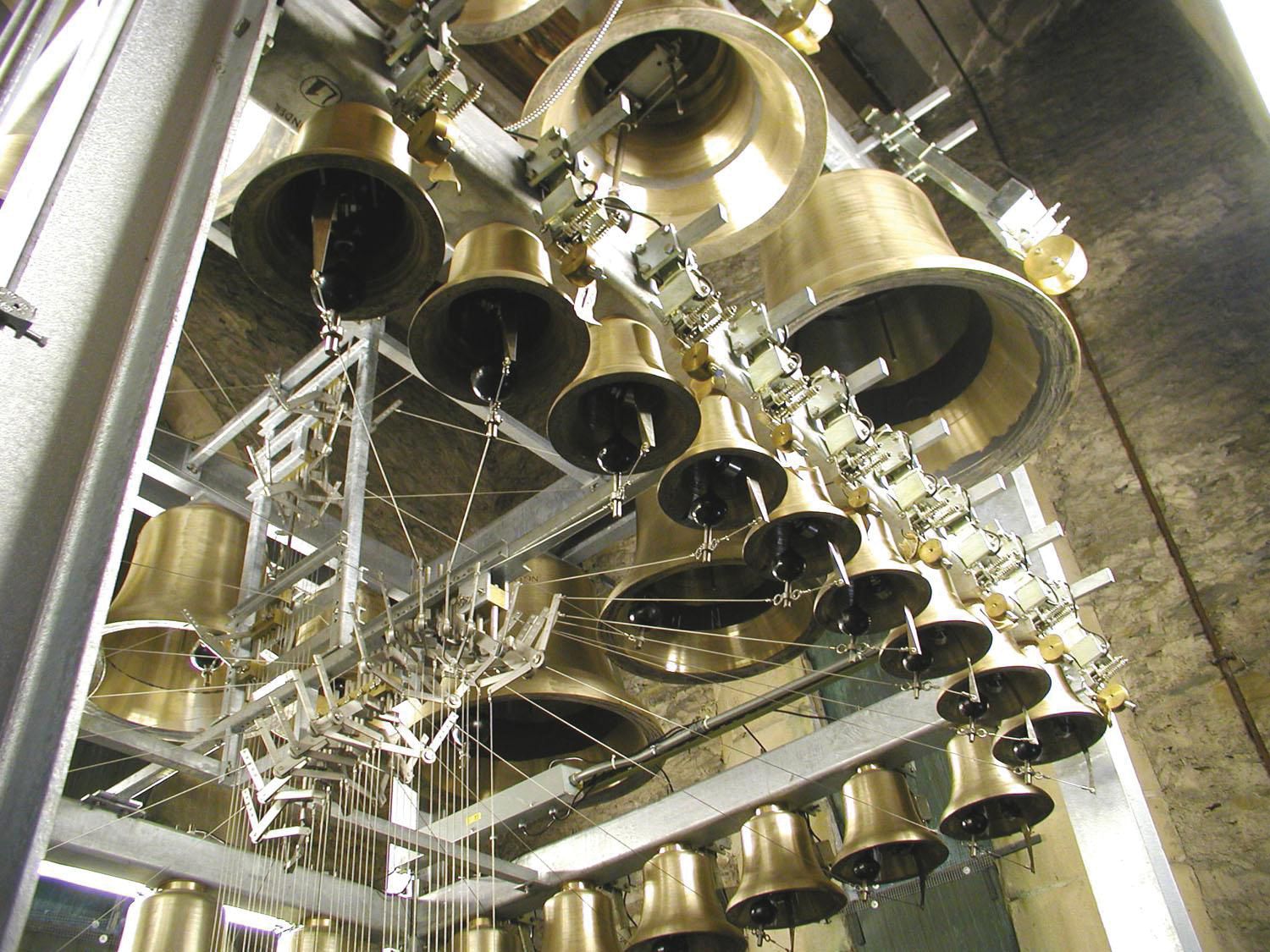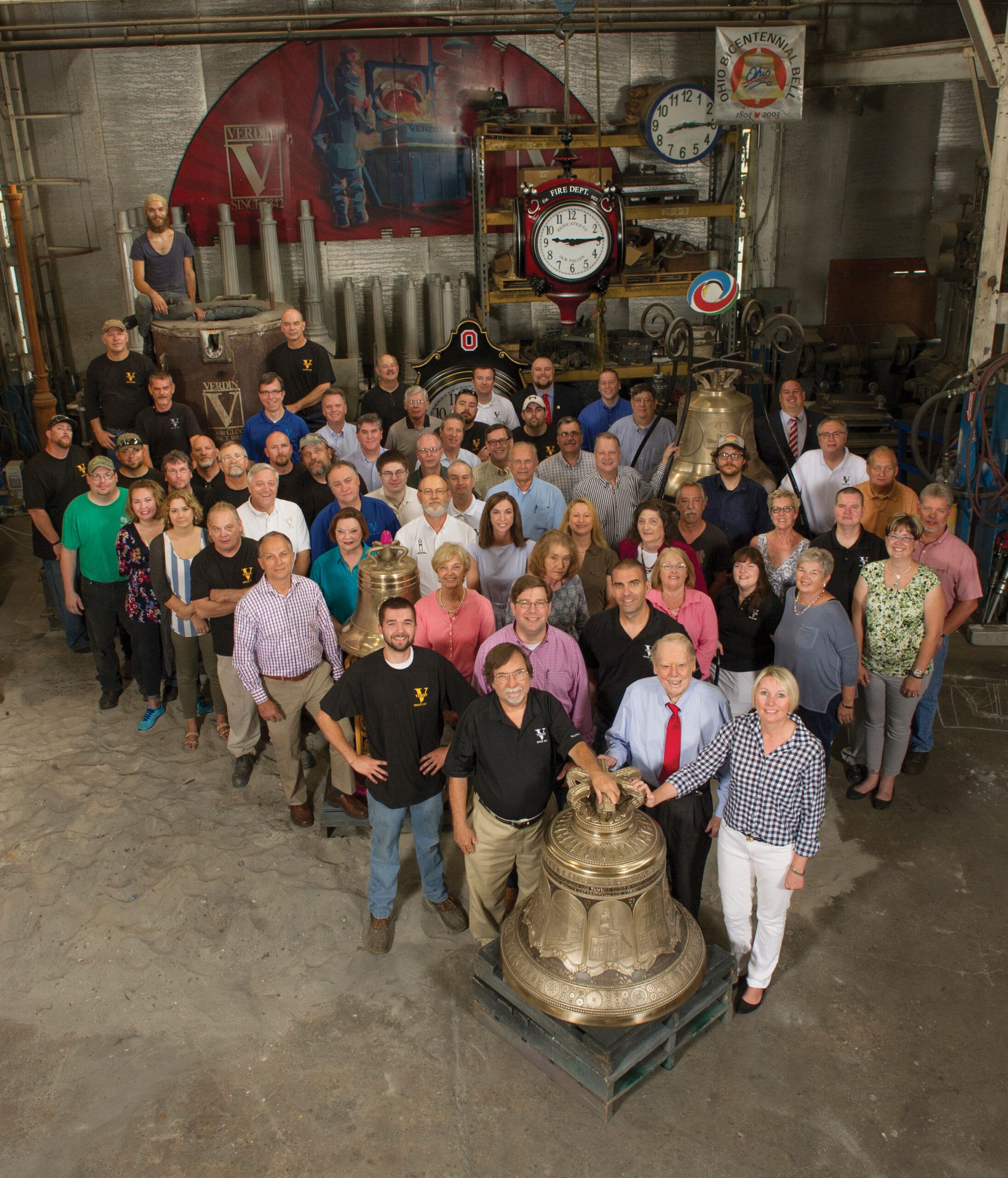The Business: The Verdin family came to the United States from the Alsace region of France around 1830 and settled in Cincinnati. Two of the seven siblings, Francis de Sales Verdin and Michael Verdin, were skilled in iron forging and clock making and began producing and repairing tower clocks. They installed their first tower clock, at Old St. Mary's Church in Cincinnati, in 1842. The Verdins soon expanded into repairing bell-ringing equipment and then began manufacturing the equipment.
 The business passed to Alois Nicholas (A.N.) Verdin, son of Francis de Sales Verdin. A.N. invented an improved winder for tower clocks and received a patent for the first automatic time lock for safes. A.N.'s son, Innes Theopholis (I.T.) Verdin, joined him in the business, which added bell restoration to its menu of services and gained recognition for its work for churches.
The business passed to Alois Nicholas (A.N.) Verdin, son of Francis de Sales Verdin. A.N. invented an improved winder for tower clocks and received a patent for the first automatic time lock for safes. A.N.'s son, Innes Theopholis (I.T.) Verdin, joined him in the business, which added bell restoration to its menu of services and gained recognition for its work for churches.
I.T. Verdin succeeded his father and proved that ingenuity ran in the family; he changed the industry with his 1927 invention of the electric bell ringer. As electricity became more widely available, “He decided that he could come up with a better way of ringing a bell so that people didn't have to pull ropes,” says Tim Verdin, 41, the sixth-generation vice president of manufacturing. “He probably invested everything he had in this bell ringer, hoping it would take off. And that's what turned our company from a Cincinnati company into more of an East Coast company. We started selling not only to churches [but also] to other bell founders.”
I.T.'s three sons, Robert Sr., Ralph and Forrest, who had worked in the business since childhood, took over after their father passed away in 1936. Under their leadership, The Verdin Company established a sales force. In 1946, the company introduced the electronic carillon, an affordable alternative to bronze bells. (Today, the company makes digital carillons.)
Fifth-generation cousins Robert Jr., James (Jim) and David bought the company from their fathers in 1971. They grew the business by selling outside the Ohio/Kentucky/Indiana region, by expanding their menu of products and services (they make cast-metal sculptures, monuments, glockenspiels and more) and by acquiring other foundries and related businesses.
“We've been fortunate to build a strong service department,” says Jim Verdin, 81, the company president. “Every time a competitor has trouble, we try to buy them—not so much to get more business, but mainly to take care of the bells.”
“The companies that were at one time really strong now have gone by the wayside,” says Tim, who is David's son. “As these competitors fall, the business that they had comes to us.”
In 1981, Verdin purchased the buildings of St. Paul's Church in Cincinnati. The church, built in 1850, was deconsecrated in 1975 and had fallen into disrepair. The company spent two years and $1.5 million restoring the church, convent, schools and rectory, transforming the site into a headquarters (the former boys' school) and showroom. Some buildings in the Verdin campus, located in the historic Over-the-Rhine neighborhood, are rented out; the old church is now used as an event space. In January 2016, a fire that started in a neighboring building spread to the Verdin headquarters building. The company moved into the former girls' school while the extensive damage was repaired.
Verdin created the massive World Peace Bell to commemorate the Universal Declaration of Human Rights. The bell, which weighs in at 66,000 lbs. and required 100,000 lbs. of bronze, was dedicated on Dec. 31, 1999. At the time, it was the world's largest swinging cast bell. The World Peace Bell, which was rung for the first time in Nantes, France, is now on display in Newport, Ky.
 The Verdin Company developed another game-changer, a “bell foundry on wheels,” in 2001. Between 2001 and 2003, the mobile foundry went to all 88 Ohio counties to cast bells on site in honor of the state's bicentennial. Today, it travels around the country, enabling community members to watch a bell being custom-made (usually to commemorate a local milestone). When the Verdins first mentioned they wanted to create a mobile foundry, friends in the industry advised against it, insisting that it couldn't be done, Tim recalls.
The Verdin Company developed another game-changer, a “bell foundry on wheels,” in 2001. Between 2001 and 2003, the mobile foundry went to all 88 Ohio counties to cast bells on site in honor of the state's bicentennial. Today, it travels around the country, enabling community members to watch a bell being custom-made (usually to commemorate a local milestone). When the Verdins first mentioned they wanted to create a mobile foundry, friends in the industry advised against it, insisting that it couldn't be done, Tim recalls.
At the start of 2017, Verdin officially launched its organ division, which sells pipe organs, hybrid organs, digital organs and pianos. The division also offers an interface that transforms an organ console into a controller for a digital carillon system, enabling a musician to play both the bells and the organ.
The Verdin Company is the oldest tower clock manufacturer in the U.S. and the largest bell and carillon supplier in the world. The company, which currently employs about 150 people, has made about 55,000 installations; sites include the New York Stock Exchange, Walt Disney World, the University of Notre Dame and the Mayo Clinic.
“Most of the work comes from word of mouth, and that's how we really are able to grow the business,” Jim says.
The company has facilities in Connecticut, South Carolina and Texas in addition to two in Cincinnati, plus sales reps and service techs nationwide; some work directly for Verdin and some are independents.
The Family: Jim Verdin is the only fifth-generation member who still works in the business. David Verdin has retired but remains an owner of the company. Robert Verdin Jr. passed away in July 2016.
In addition to Tim, two other sixth-generation members work in the company: Jim's daughter, Jill Verdin Crew, 50, vice president of real estate, and Bob Verdin III, 50, vice president of sales. G7 member Bob Verdin IV, 19, a sophomore at the University of Mississippi, worked for the company as a truck driver during the summer.
The family has been fortunate that over six generations, “There was always somebody here that wanted to continue the business,” Jim says.
The Celebration: The Verdin Company staged two celebrations to commemorate its 175th anniversary. The first took place in June in conjunction with the Guild of Carillonneurs in North America, which coincidentally was holding its 75th congress in Ohio. The June event included a dinner and tour for the carillonneurs, a bell casting on Verdin's mobile foundry and a concert.
As one might expect, Verdin produced a special bell to commemorate its 175th anniversary, featuring scenes from the company's history and the names of family members. The bell, which weighs 1,100 lbs., was unveiled at the June event and will be displayed at company headquarters on a newly built stand that will enable it to be viewed in the round.
 The Verdin foundry was again the site of a party on September 15. More than 150 people attended, including preferred customers, extended family, vendors, friends and politicians. The event featured factory tours, lunch, a bell casting on the traveling bell foundry and two cakes (one shaped like a bell, the other like a clock).
The Verdin foundry was again the site of a party on September 15. More than 150 people attended, including preferred customers, extended family, vendors, friends and politicians. The event featured factory tours, lunch, a bell casting on the traveling bell foundry and two cakes (one shaped like a bell, the other like a clock).
Richard Finan, mayor of Evendale, Ohio, and the former president of the Ohio Senate, served as master of ceremonies. In attendance were Stephen Caraway, southwestern Ohio liaison to Gov. John Kasich; Lisa Hayes, southwestern Ohio liaison to Lt. Gov. Mary Taylor; Alex Scharfetter, deputy district director, office of U.S. Rep. Brad Wenstrup (R-Ohio); State Rep. Catherine Ingram (D-32nd District); Mark Mallory, former mayor of Cincinnati; James Tarbell, former Cincinnati vice mayor; Hamilton County Commissioner Chris Monzel; Auxiliary Bishop Joseph Binzer of the Archdiocese of Cincinnati; and Frank and Tomas Fritsen of the Petit and Fritsen Bell Foundry of Aarle Rixel, Holland.
“I was really surprised at how many dignitaries took time out of their day to come by and celebrate with us,” Jill says.
Later that afternoon, Rodney Barbour, the former organist for the Cincinnati Reds, was the featured artist at a bell and organ concert that was open to the public. Barbour played three sets. “So many people stayed the whole three-and-a-half or four hours, listening to this gentleman playing the organ. That was really special,” Jill says.
The Response: During the September celebration, Jim Verdin “was in his glory,” says Jill, his daughter. Many old friends turned out for the event, including some he hadn't seen for decades, she notes. “It was really touching,” she says. “They were bringing him cards and saying how thankful that they are that this company is still in Cincinnati, and still a family-run business, and still going on strong.”
The week after the celebration, The Verdin Company moved back into its headquarters after a lengthy renovation necessitated by the 2016 fire. “That gives us another opportunity to celebrate,” Jill says. Once the staff have settled into their newly remodeled digs, the family will decide whether to ring in the company's 176th year with an open house, she says.
The Advice: Jill notes that the company began planning its 175th anniversary celebration about a year in advance. “I think that's why it went off so successfully—because they had been planning things for quite some time. So don't wait until right before you want to celebrate [to start planning an event],” she urges.
 Beginning in January, The Verdin Company promoted its 175th anniversary year on its website and on social media. Neighbors, customers and other fans posted congratulatory notes on Verdin's Facebook page immediately thereafter. That stirred up anticipation for the celebration six months before the first event. “It is a milestone to get to 175 years, so we wanted to do it right,” Jill says.
Beginning in January, The Verdin Company promoted its 175th anniversary year on its website and on social media. Neighbors, customers and other fans posted congratulatory notes on Verdin's Facebook page immediately thereafter. That stirred up anticipation for the celebration six months before the first event. “It is a milestone to get to 175 years, so we wanted to do it right,” Jill says.
The Secret Sauce: Sustaining a family business for 175 years is a towering achievement. To what does the family attribute its success?
Innovation and fearlessness have been key factors, according to Tim. Family members “have not been afraid to try the impossible,” he says. “We've never settled for just maintaining our current product line or maintaining our current customer base. We've always taken chances on things that have never been done before. We've done a good job through the years of recognizing the market trends and knowing when it was time to bring something to market.”
“Some ideas go out of favor, and we're already thinking of another idea,” Jim notes.
Of the company's many noteworthy achievements, Tim says those that make him the proudest are the ones that involved big risks and high payoff—“where we did something that nobody else would have the nerve [to try], or everybody else in the industry said was impossible, and we were able to pull it off. And I think that's what really makes our company so special.”
Tim offers a ringing endorsement of the company's non-family employees, both past and present, noting that he's heard stories of many “superstar employees” whose work helped the company grow and acquire its good reputation.
Despite setbacks like the fire at its headquarters, there's no question that fate has smiled on the company through the generations, Tim says. “I don't know if it's accidental—that [family members] just kind of lucked into these decisions that turned out to be really good—or if it's just sheer hard work, but there's been an awful lot of decisions that were made in the past that turned out to be really, really good for the company,” he says.
The family's keen instincts have helped them prosper not only from business operations, but also “with other things, like properties that we've purchased that have turned out to be really great investments for the company,” Tim says. “It's kind of the perfect recipe that's made us so successful through the years.”
Copyright 2017 by Family Business Magazine. This article may not be posted online or reproduced in any form, including photocopy, without permission from the publisher. For reprint information, contact bwenger@familybusinessmagazine.com.

